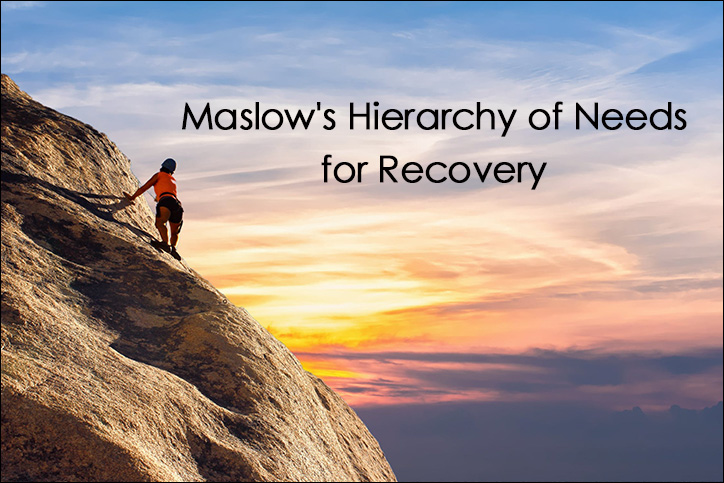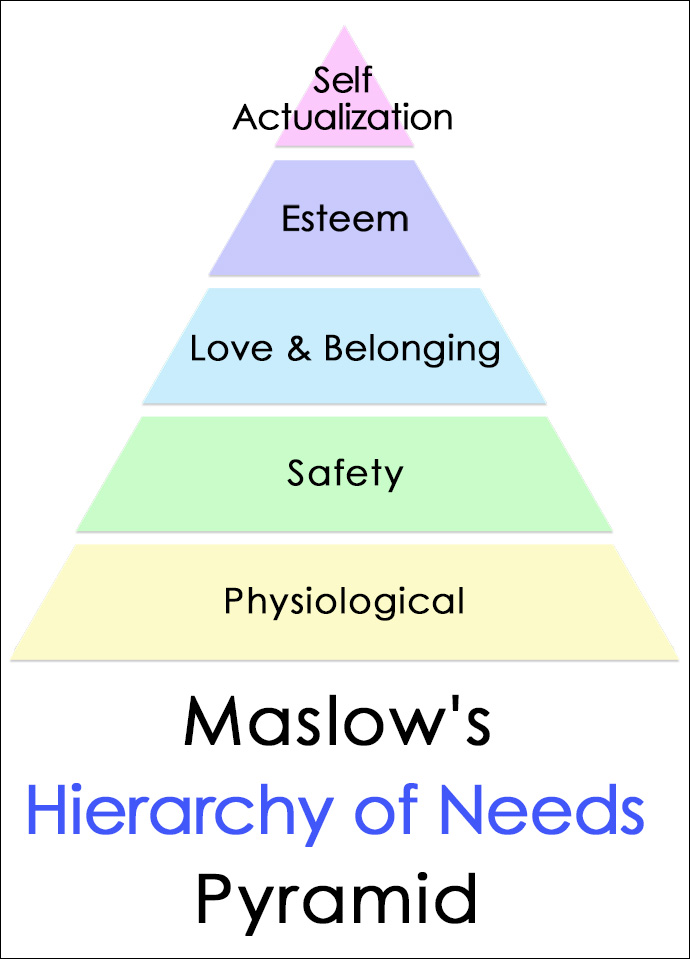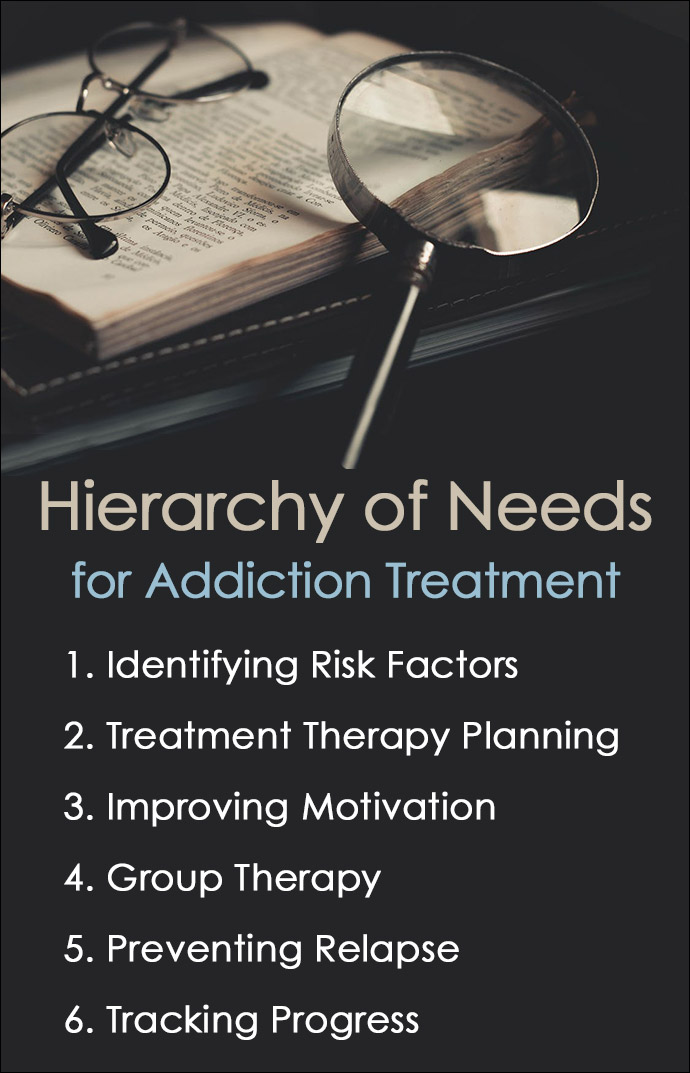Table of Contents
Maslow’s Hierarchy of Needs is a theory of human needs and motivation created by psychologist Abraham Maslow.
It is one of the most popular theories of motivation and has been used as a framework in psychiatry, education, social work, and even business management for understanding human behavior.
It also plays a role in understanding the relationship between motivation and addiction recovery.
What is Maslow’s Hierarchy of Needs?
Maslow’s Hierarchy of Needs is usually illustrated as a 5-level pyramid with the most basic human needs at the bottom and the most complex need for self-actualization at the top.
5 Levels of Maslow’s Hierarchy of Needs
- Physiological Needs
- Safety Needs
- Love and Belonging Needs
- Esteem Needs
- Self-Actualization Needs
Abraham Maslow developed his motivational Hierarchy of Needs theory based on his own personal clinical experience and by observing human behavior.
He was one of the founding fathers of humanistic psychology, which focuses on human potential rather than pathology. This shaped his interest in understanding human motivation.
He studied the writings of historical figures and observed university students, faculty, and business professionals to gain a better understanding of their needs and motivation.
His own personal loneliness and insecurity as a child led him to study self-esteem and identify ways of overcoming it.
Maslow’s Hierarchy of Needs Theory is based on his own belief and observation that human motivation evolves over time , beginning with basic survival needs and progressing to higher intellectual and cognitive needs.
Later in life, beginning in the 1960s, he extended his original five levels and eventually added three more above the top level of self-actualization needs.
Later Levels of Needs
- Cognitive Needs (knowledge)
- Aesthetic Needs (beauty, balance, quality over quantity)
- Self-Transcendence Needs (spiritual understanding of something greater than oneself)
While the original 5-tier model is what most people still refer to, Maslow realized human motivation is more complex than he originally envisioned.
As the five basic human needs are met, people will pursue more advanced psychological fulfillment through knowledge, aesthetics, and transcendence.
What are the 5 Levels of Maslow’s Hierarchy of Needs?
Maslow’s Hierarchy of Needs pyramid begins with the most fundamental level (physiological needs) at the bottom and the most complex (self-actualization) at the top.
He theorized that basic needs must be met first, and when they are, people become motivated to pursue more advanced needs higher up the pyramid.
1. Physiological Needs – Bottom Level
Physiological needs are the most basic human needs. These are essential for basic survival and include air (oxygen), water, food, clothing, shelter, and sleep. Without fulfilling these fundamental needs, the human body cannot function or stay alive for long.
According to Maslow, physiological needs must be met first before any other needs become motivators for behavior.
A person struggling with poverty or homelessness is strongly motivated by hunger to find their next meal before seeking the need of belonging to a community.
Physiological needs are seen as the strongest motivators of behavior and must be met first before progressing higher up the hierarchy.
2. Safety Needs
Once physiological needs are met, a person’s attention turns to safety and security needs to ensure they feel safe, protected, and free from any type of threats.
Safety needs include personal security, financial stability, health and wellbeing, and safety from crime or natural disasters.
Examples of safety needs include purchasing health insurance, installing home security systems, seeking employment, or putting money into a savings account.
These needs are motivated by the desire to feel safe and protected. However, if physiological needs arise, they take priority over safety needs until a person becomes stable again.
3. Love and Belonging Needs
After physiological and safety needs are met, the next tier in the hierarchy is Love and Belonging, which encompasses the need for intimacy, relationships, and being part of a community.
Love and Belonging needs are motivational social behaviors related to building friendships, engaging in family bonding, intimacy in romantic relationships, and seeking a connection and belonging to social groups or communities.
Building and maintaining positive relationships with others is a powerful motivator after physiological and safety requirements have been met.
4. Esteem Needs
Once love and belonging needs are fulfilled, a person is motivated by Esteem needs.
Esteem is the desire to feel a sense of personal worth and value, and to be respected by others.
Two Types of Esteem
1. Internal Self-Esteem is a confidence in oneself and personal achievements.
2. External Esteem from others is a form of recognition, approval, and praise by other people.
After love and belonging is fulfilled, esteem needs focus on finding ways to feel respected, appreciated, and improve a person’s self-worth through hard work, promotions, and other types of recognition.
5. Self-Actualization Needs – Top Level
Maslow’s original 5-tier pyramid considers Self-Actualization Needs as the highest level a person achieves when they realize they have reached their full potential.
This level may be difficult to attain, yet it motivates a person to seek out new challenges and opportunities for further development.
Self-actualization results in a sense of fulfillment and achieving one’s full capabilities.
There is no end to this need as self-actualization needs continue to motivate behavior.
The hierarchy of needs continues to be relevant in understanding human behavior and motivation today.
Maslow’s Hierarchy of Needs is Useful for Mental Health Treatment
Maslow’s Hierarchy of Needs is used in psychiatry and mental health treatment to help assess patient needs and create effective treatment plans.
6 Ways to Use Maslow’s Hierarchy of Needs for Mental Health Treatment
1. Assessing Motivation
Mental health providers can assess which levels of needs are not being met to help determine what is causing a patient’s negative or unhealthy behaviors. This is useful for establishing a treatment plan.
2. Treatment Planning
Identifying unmet needs is helpful for therapists to create treatment programs that target those unmet needs.
3. Measuring Treatment Outcomes
When a person progresses through Maslow’s hierarchy, it can indicate an improvement in mental health issues as more fundamental needs are met.
4. Understanding Mental Illness
Mental illnesses can develop or become worse when a person is not able to satisfy certain needs such as belongingness or esteem.
5. Group Therapy
Group therapy activities can help patients learn how to improve self-actualization, esteem, or social needs in a supportive environment.
6. Promoting Self-Awareness
Understanding the hierarchy is beneficial for individuals to gain insight into their unmet needs and learn coping strategies and motivational techniques.
Maslow’s Hierarchy of Needs can assist mental health professionals in assessing client struggles and recognizing unfulfilled needs to address in treatment.
One of the most important Gestalt Therapy techniques focuses on personal self-awareness and motivation for healing.
Maslow’s Hierarchy of Needs for Addiction Treatment Recovery
Maslow’s Hierarchy of Needs is useful for understanding the relationship between motivation and addiction to determine effective therapies for treatment.
6 Ways Maslow’s Hierarchy of Needs is Beneficial for Addiction Treatment Recovery
1. Identifying Risk Factors
When the lower level physiological, safety, belongingness, and esteem needs are not met, the risk of addiction can increase as people turn to substances for temporary relief. Overcoming unfulfilled needs is beneficial for relapse prevention.
2. Treatment Therapy Planning
Addiction treatment programs should address unmet needs and encourage clients to boost self-esteem through counseling, lifestyle changes, and building social support networks.
3. Improving Motivation
Helping clients fulfill unmet needs of esteem, belongingness, and self-actualization will improve motivation to maintain and continue sobriety.
4. Group Therapy
Group therapy offers support and opportunities to cultivate belongingness and esteem that are essential for recovery.
5. Preventing Relapse
Continued support in recovery treatment ensures that basic needs are met and reduces the risk of relapse.
6. Tracking Progress
Tracking progress during addiction treatment monitors upward movement through Maslow’s hierarchy and prevents going backwards by confirming basic needs are always met.
Monitoring and focusing on underlying unmet needs related to motivation and addictive behaviors helps guide individualized treatment plans and relapse prevention strategies that support long-term recovery.
What is the Relationship Between Motivation and Addiction?
To understand the relationship between motivation and addiction, it’s necessary to know how it is processed in the brain.
The reward and motivation pathways in the brain are closely tied to neurotransmitters. Dopamine released into the nucleus accumbens and prefrontal cortex affects pleasure, motivation, and rewards.
This area is known as the “reward pathway” or “pleasure center” of the brain where dopamine strengthens motivation and drives us to seek out certain rewards.
Other dopamine pathways are also important for motivation, decision-making, and behavior to obtain healthy rewards.
Unfortunately, addiction hijacks this area of the brain and motivates people to seek out the “feel good” reward supplied by addictive drugs or alcohol instead of healthier activities.
Learning how to increase dopamine naturally can be effective for improving motivation.
The Impact of Maslow’s Hierarchy of Needs on Motivation and Addiction
1. Motivation Fuels Addictive Behaviors
People struggling with addiction are often motivated to continue substance use through negative reinforcement by using drugs or alcohol to escape or cope with emotional pain such as depression, anxiety, or trauma.
They are motivated by seeking relief from mental pain and the pleasure of using addictive substances, even though the relief is only temporary.
2. Addiction Destroys Positive Motivation
As addiction progresses, drugs and alcohol negatively impact the brain’s reward and motivation pathways. People become less motivated by things they previously found enjoyable, like relationships or hobbies.
3. Recovery Boosts Positive Motivation
Addiction treatment involves healing and restoring motivation that has been hijacked by addiction and focuses on the positive reward of sobriety and recovery.
4. Relapse Risk of Unmet Needs
People in recovery remain vulnerable if their basic needs highlighted in Maslow’s Hierarchy are not met and they face the potential for relapse.
The term dry drunk applies to people who have stopped using alcohol, but they have not resolved their unmet needs, so they are at risk of relapse.
Joining supportive communities and improving esteem will increase the motivation needed to maintain sobriety and thrive in recovery.
Understanding Maslow’s Hierarchy of Needs is important for mental health and addiction recovery.
Basic needs must be met first before progressing to a higher level. Fulfilling physiological needs provides the motivation necessary for continued growth to reach self-actualization and a person’s true potential.






